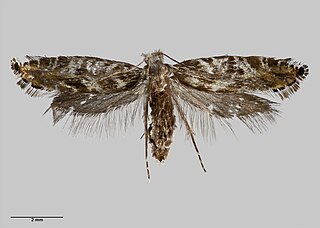Related Research Articles
Ectoedemia quinquella is a moth of the family Nepticulidae. It is found from Great Britain and France to Italy, Bulgaria and Greece.
Asterivora ministra is a species of moth in the family Choreutidae. It is endemic to New Zealand.
Glyphipterix archimedica is a moth in the family Glyphipterigidae. It is known from Zimbabwe.
Glyphipterix ortholeuca is a moth in the family Glyphipterigidae. It is known from South Africa.
Helcystogramma gypsaspis is a moth in the family Gelechiidae. It was described by Edward Meyrick in 1921. It is found on Java in Indonesia.
Onebala amethystina is a moth in the family Gelechiidae. It was described by Edward Meyrick in 1904. It is found in Australia, where it has been recorded from New South Wales and Queensland.
Onebala choristis is a moth in the family Gelechiidae. It was described by Edward Meyrick in 1904. It is found in Australia, where it has been recorded from Western Australia, New South Wales and Queensland.
Ardozyga deltodes is a species of moth in the family Gelechiidae. It was described by Oswald Bertram Lower in 1896. It is found in Australia, where it has been recorded from Victoria and New South Wales.
Holophysis auxiliaris is a moth of the family Gelechiidae. It was described by Edward Meyrick in 1918. It is found in Colombia.
Aristotelia argyractis is a moth of the family Gelechiidae. It was described by Edward Meyrick in 1923. It is found in Amazonas, Brazil.
Nealyda panchromatica is a moth of the family Gelechiidae. It was described by Edward Meyrick in 1926. It is found in Assam, India.
Tisis hemixysta is a moth in the family Lecithoceridae. It was described by Edward Meyrick in 1910. It is found on Borneo.
Synchalara argoplaca is a moth in the family Xyloryctidae. It was described by Edward Meyrick in 1907. It is found in Sri Lanka.
Hastamea argentidorsella is a moth in the family Depressariidae, and the only species in the genus Hastamea. It was described by August Busck in 1911 and is found in Brazil (Paraná).
Idiocrates is a monotypic moth genus in the family Depressariidae. Its only species, Idiocrates balanitis, is found in Bolivia. Both the genus and species were first described by Edward Meyrick in 1909.
Eupselia tristephana is a moth in the family Depressariidae. It was described by Edward Meyrick in 1915. It is found in Australia, where it has been recorded from Western Australia, the Northern Territory and Queensland.
Stenoma chionogramma is a moth in the family Depressariidae. It was described by Edward Meyrick in 1909. It is found in Brazil (Amazonas), Peru and Bolivia.
Apostibes aerata is a moth of the family Scythrididae. It was described by Lord Walsingham in 1914. It is found in Mexico (Guerrero).
Apostibes mesopora is a moth of the family Scythrididae. It was described by Lord Walsingham in 1914. It is found in Mexico (Guerrero).

Tinea astraea is a species of moth in the family Tineidae. It was described by Edward Meyrick in 1911. However the placement of this species within the genus Tinea is in doubt. As a result, this species has been referred to as Tinea (s.l.) astraea. This species is endemic to New Zealand.
References
- ↑ Apostibes at Markku Savela's Lepidoptera and Some Other Life Forms.
- ↑ Biologia Centrali-Americana: Lepidoptera Heterocera 4: 322
| This article on a moth of the family Scythrididae is a stub. You can help Wikipedia by expanding it. |